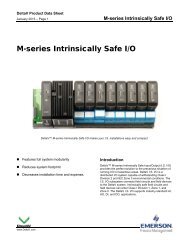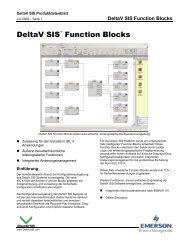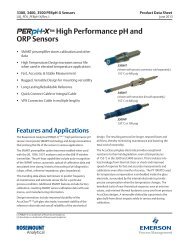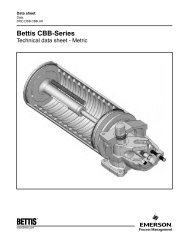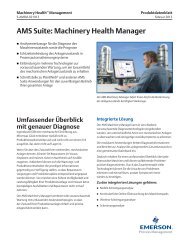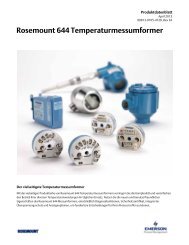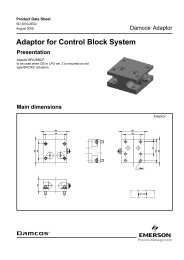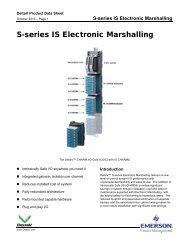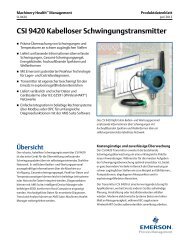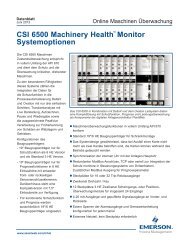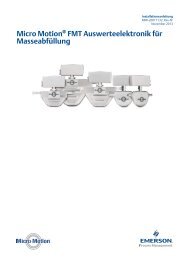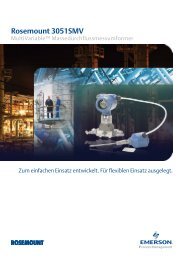Rosemount 3051S Electronic Remote Sensors - Emerson Process ...
Rosemount 3051S Electronic Remote Sensors - Emerson Process ...
Rosemount 3051S Electronic Remote Sensors - Emerson Process ...
You also want an ePaper? Increase the reach of your titles
YUMPU automatically turns print PDFs into web optimized ePapers that Google loves.
Reference Manual<br />
00809-0100-4804, Rev AA<br />
January 2011<br />
Consider Housing<br />
Orientation<br />
<strong>Rosemount</strong> <strong>3051S</strong> ERS System<br />
Impulse Piping<br />
The piping between the process and each ERS sensor must accurately<br />
transfer the pressure to obtain accurate measurements. There are many<br />
possible sources of error: pressure transfer, leaks, friction loss (particularly if<br />
purging is used), trapped gas in a liquid line, liquid in a gas line, and plugged<br />
impulse lines.<br />
The best location for each ERS sensor depends on the process itself. Use the<br />
following guidelines to determine sensor location and placement of impulse<br />
piping:<br />
• Keep impulse piping as short as possible.<br />
• For liquid service, slope the impulse piping at least 1 inch per foot (8<br />
cm per m) upward from the transmitter toward the process connection.<br />
• For gas service, slope the impulse piping at least 1 inch per foot (8 cm<br />
per m) downward from the transmitter toward the process connection.<br />
• Avoid high points in liquid lines and low points in gas lines.<br />
• When purging, make the purge connection close to the process tap and<br />
purge through equal lengths of the same size pipe. Avoid purging<br />
through either <strong>3051S</strong> ERS sensor.<br />
• Keep corrosive or hot (above 250 °F or 121 °C) process material out of<br />
direct contact with the sensor module process connection and flanges.<br />
• Prevent sediments from depositing in the impulse piping.<br />
NOTE:<br />
Take necessary steps to prevent process fluid from freezing with the process<br />
flange to avoid damage to the <strong>3051S</strong> ERS sensor.<br />
NOTE:<br />
Verify the zero point on each ERS sensor after installation. To reset the zero<br />
point, refer to “Calibration Overview” on page 4-3.<br />
Housing Rotation<br />
The housing can be rotated to improve access to wiring or to better view the<br />
LCD display (if ordered). To rotate the housing, perform the following<br />
procedure:<br />
1. Loosen the housing set screw.<br />
2. Turn the housing up to 180 degrees to the left or right of its original<br />
(as shipped) position.<br />
NOTE:<br />
Do not rotate the housing more than 180 degrees from its original position<br />
without first performing a disassembly procedure (see page 4-8). Over<br />
rotation may sever the electrical connection between the sensor module and<br />
the electronics featureboard.<br />
3. Retighten the housing rotation set screw.<br />
2-11



